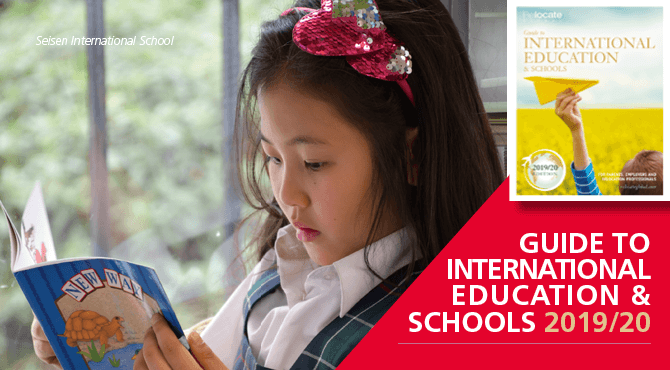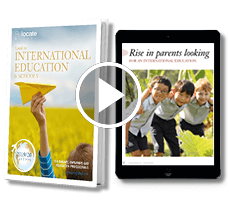Education and schools in Japan
With a high number of Fortune Global 500 companies and a standard of living to rival the UK’s, Japan is the destination of choice for many relocating families. We take a look at how international schools are meeting the needs of both locals and expatriates there.
 Universities in Japan now accept the IB and offer courses in English, especially as they are much less expensive than the UK and US. The demand for Japanese universities is very high which, in turn, is creating a need for more international schools as a route to entry.
Universities in Japan now accept the IB and offer courses in English, especially as they are much less expensive than the UK and US. The demand for Japanese universities is very high which, in turn, is creating a need for more international schools as a route to entry.Early years provision
Good childcare options are available in Japan, but places are in great demand, thanks to a large number of working mothers. There are four options:- State-run nurseries (Ho-Iku-en)
- Private Japanese nurseries (Yo-Chi-en)
- International preschools
- Full-time nannies and babysitters
International schools: primary and secondary
Seisen International, a Catholic girls’ school in Tokyo, has been in existence for more than 50 years. At kindergarten level, the school follows the Montessori curriculum. At elementary and high-school level, it offers the International Baccalaureate (IB).“While academic achievement is central to life at Seisen, there is also a strong focus on social action. The school partners with several schools in developing countries, and supports local charities while educating the students about those in need. In Tokyo it is easy to find a ‘good’ school,” explains head of school, Colette Rogers. “All twelve schools in Tokyo that are members of the Japan Council of International Schools provide an internationally recognised education. The focus should be on finding the right school for your family’s needs.”Seisen is the only school in Japan that is a member of the National Coalition of Girls' Schools. It has a co-ed kindergarten, but is girls only from Grades 1-12. Rogers explains, “An all-girls school provides a nurturing environment where girls fill every leadership position in every group. This environment is designed to give girls the unique support they need to achieve their highest academic potential.”The majority of international schools in Japan offer a US or a bilingual curriculum. The British School in Tokyo (BST) is one of just six per cent of schools that offer the UK curriculum.The BST was founded in 1989 and has more than 1,000 students, building a strong reputation among Tokyo’s international community. As a result, there are waiting lists in most year groups. There are now over 63 different nationalities at the school, but families on short-term assignments are no longer the main demographic. “Our biggest demographic now is probably the more long-term stayers in Japan, often dual-nationality, where one of the parents is Japanese. Therefore, they see themselves as being a part of the school community for some considerable amount of time, perhaps all the way through from three to 18 in some cases,” BST says.The school is a COBIS member and the BST is quick to highlight the importance of this accreditation for relocating parents, “Look at the membership group of the school that you’re applying to. Particularly if you’re a first-time parent going overseas, it must be tremendously reassuring to have that.”Founded in 1902, The American School in Japan follows the American school system and – at high-school level – offers over 22 Advanced Placement (AP) courses, as well as the AP Capstone Diploma. The school caters for students from kindergarten through to Grade 12. With over 1,650 students, it is one of the largest international schools in Tokyo.Another popular school is The Montessori School of Tokyo, which was Japan’s first Montessori elementary school. It caters for 150 students of 33 nationalities up to the age of 14.UK-Japan trading relationship
On her trade visit to Japan in August 2017, former UK Prime Minister Theresa May led a business delegation that aimed to showcase the strength of British business and continue to build the UK-Japan economic relationship as the UK prepares to leave the EU.Japan is one of the largest global markets for UK goods and services and the fourth-largest provider of overseas investment into the UK. Automotive manufacturing is a prime example: both Nissan and Toyota manufacture cars in the UK, the vast majority going to the EU and Mrs May was keen to maintain this relationship post-Brexit.The Japanese government is equally keen to attract foreign talent to its shores, owing to the rapid decline in the working-age population. Recent initiatives, such as a points-based immigration system that actively encourages visa applications from skilled foreign nationals, have resulted in an influx of foreign workers in the past five years.Science and innovation
Moving to Japan is not without its risks, however. As the most seismically active area in the world, the country is subject to frequent tremors of varying intensity and there is the ongoing threat from North Korea.In March 2011, following the Great East Japan Earthquake and Tsunami, there was a major incident at Fukushima Daiichi nuclear power plant. The decommissioning challenge that remains is huge, and scientists from the UK and Japan are collaborating on projects that use ultrasonic imagery and robotics to remove radioactive debris.The Japanese are at the forefront of the electronics and robotics industries, something that will be evident to any visitor to Japan. This has a strong influence on education in the country, as the BST explains, “The most popular courses for our students to go to would be STEM courses in London. Our expat students have no fear of maths and physics. We have no problem at all getting girls to do maths and physics and to undertake engineering courses when they leave school. What is interesting to me is how hard it is to get boys to do biology-based courses.”This article is from Relocate Global's Guide to International Education & Schools 2019/20 which is packed with expert tips and information for those relocating and the professionals supporting them. For volume options, co-branded editions, digital or online licence agreements and advertising opportunities, contact Fiona Murchie at +44 (0)1892 891334 or email fiona@relocatemagazine.comNow available as an ebook on Amazon! Simply download from Amazon onto your Kindle, mobile phone or tablet to read wherever you are!
Subscribe to Relocate Extra, our monthly newsletter, to get all the latest international assignments and global mobility news.Relocate’s new Global Mobility Toolkit provides free information, practical advice and support for HR, global mobility managers and global teams operating overseas.
 Access hundreds of global services and suppliers in our Online Directory
Access hundreds of global services and suppliers in our Online Directory For more education and school-related news, visit our Education and Schools pages.© 2019. This article first appeared in the 2019/20 edition of the Guide to International Education & Schools published by Relocate Global, Spray Hill, Hastings Road, Lamberhurst, Kent TN3 8JB. All rights reserved. This publication (or any part thereof) may not be reproduced in any form without the prior written permission of Relocate Global. Relocate Global accepts no liability for the accuracy of the contents or any opinions expressed herein.
For more education and school-related news, visit our Education and Schools pages.© 2019. This article first appeared in the 2019/20 edition of the Guide to International Education & Schools published by Relocate Global, Spray Hill, Hastings Road, Lamberhurst, Kent TN3 8JB. All rights reserved. This publication (or any part thereof) may not be reproduced in any form without the prior written permission of Relocate Global. Relocate Global accepts no liability for the accuracy of the contents or any opinions expressed herein.©2025 Re:locate magazine, published by Profile Locations, Spray Hill, Hastings Road, Lamberhurst, Kent TN3 8JB. All rights reserved. This publication (or any part thereof) may not be reproduced in any form without the prior written permission of Profile Locations. Profile Locations accepts no liability for the accuracy of the contents or any opinions expressed herein.




































